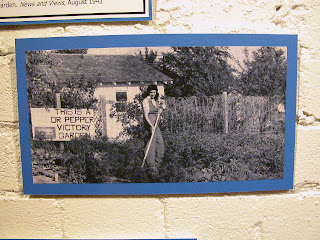I’m not really sure how it happened, but growing up I fell in love with a romanticized version of World War Two. Something about that era captivates me and anything that remotely has to do with the war effort completely fascinates me. Old movies, war propaganda posters and especially the Imperial War Museum in London have fueled my curiosity, but it took the Dr Pepper Museum to broaden my interest by exploring the soft drink industry’s role in several different wars.
Nestled opposite a classic grocery truck on the second floor is a white wall featuring vintage magazine ads, pictures and posters. It is easily overshadowed by the constant loop of Dr Pepper commercials playing around the corner, but some of the most interesting Dr Pepper history is found on that wall and should not be ignored.

Initially, I was attracted to the World War II aspect of the exhibit. Once America joined the fight in Europe, rationing hit Americans hard. While our boys were off fighting the home front had to keep the country running. Soft drinks were originally deemed unnecessary and were subject to rationing until Dr Pepper President J.B. O’Hara launched a study that proved the drink had essential nutrients that qualified it as a food. Thus, the ‘liquid bite’ was established and led to the 10-2-4 campaign.
Dr Pepper also launched an aggressive ad campaign designed to inspire the home front to support the troops. Ads in 1943 asserted that “Dr Pepper helps home-front workers fight hunger, thirst and fatigue” if drunk after working in a ‘victory garden.’
Another Dr Pepper ad featured a young girl resembling Dorothy from the Wizard of Oz encouraged the war effort at home by proclaiming, “Onward Garden Soldiers.”

Dr Pepper helped to promote the idea of victory gardens where individual families ate fresh foods straight from their gardens to decrease the national demand of food so industrial farmers could focus on feeding the troops. The nation took the concept to heart, and 20 million Americans planted these gardens. Some even called them Dr Pepper Freedom Gardens.

The wall covers more than Dr Pepper’s involvement in World War II, yet the entire exhibit holds my attention. From civil war veterans to soldiers fighting in Iraq today, Dr Pepper has always been a favorite of the troops, and Dr Pepper has been there to support them. Everyone from Roosevelt and his rough riders in 1989 to World War II feminists enjoyed the original taste of the soft drink.
Even soldiers today enjoy a taste of home in the form of Dr Pepper, but some take it more seriously than others.

The oldest photograph on the wall features an old man happily sipping Dr Pepper. Colonel C.W. Matthews was a Civil War veteran and celebrated his 102nd birthday with a 24-bottle case of Dr Pepper. It’s amazing to think that Dr Pepper was around when Matthews was the driver to bring peace emissaries to Appomattox Courthouse.
Even though I’ve always been fascinated by WWII memorabilia, the pictures from other wars captured my attention. This exhibit offers a broader look into a single company’s effort to support America regardless of its foreign policy by exploring its role in other wars.

No comments:
Post a Comment